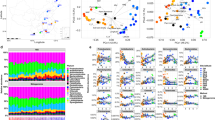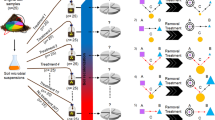Abstract
Bacterial communities are essential for the functioning of the Earth’s ecosystems1. A key challenge is to quantify the functional roles of bacterial taxa in nature to understand how the properties of ecosystems change over time or under different environmental conditions2. Such knowledge could be used, for example, to understand how bacteria modulate biogeochemical cycles3, and to engineer bacterial communities to optimize desirable functional processes4. Communities of bacteria are, however, extraordinarily complex with hundreds of interacting taxa in every gram of soil and every millilitre of pond water5. Little is known about how the tangled interactions within natural bacterial communities mediate ecosystem functioning, but high levels of bacterial diversity have led to the assumption that many taxa are functionally redundant6. Here, we pinpoint the bacterial taxa associated with keystone functional roles, and show that rare and common bacteria are implicated in fundamentally different types of ecosystem functioning. By growing hundreds of bacterial communities collected from a natural aquatic environment (rainwater-filled tree holes) under the same environmental conditions, we show that negative statistical interactions among abundant phylotypes drive variation in broad functional measures (respiration, metabolic potential, cell yield), whereas positive interactions between rare phylotypes influence narrow functional measures (the capacity of the communities to degrade specific substrates). The results alter our understanding of bacterial ecology by demonstrating that unique components of complex communities are associated with different types of ecosystem functioning.
This is a preview of subscription content, access via your institution
Access options
Access Nature and 54 other Nature Portfolio journals
Get Nature+, our best-value online-access subscription
$29.99 / 30 days
cancel any time
Subscribe to this journal
Receive 12 digital issues and online access to articles
$119.00 per year
only $9.92 per issue
Buy this article
- Purchase on Springer Link
- Instant access to full article PDF
Prices may be subject to local taxes which are calculated during checkout



Similar content being viewed by others
References
Falkowski, P., Fenchel, T. & Delong, E. The microbial engines that drive Earth’s biogeochemical cycles. Science 320, 1034–1039 (2008).
Allison, S. & Martiny, J. Resistance, resilience, and redundancy in microbial communities. Proc. Natl Acad. Sci. USA 105, 11512–11519 (2008).
Strickland, M. S., Lauber, C., Fierer, N. & Bradford, M. A. Testing the functional significance of microbial community composition. Ecology 90, 441–451 (2009).
Graham, D. W. & Smith, V. H. Designed ecosystem services: application of ecological principles in wastewater treatment engineering. Front. Ecol. Environ. 2, 199–206 (2004).
Quince, C., Curtis, T. P. & Sloan, W. T. The rational exploration of microbial diversity. ISME J. 2, 997–1006 (2008).
Finlay, B. J., Maberly, S. C. & Cooper, J. I. Microbial diversity and ecosystem function. Oikos 80, 209 (1997).
Bell, T. et al. in Biodiversity, Ecosystem Functioning, and Human Wellbeing: An Ecological and Economic Perspective (eds Naeem, S. et al.) 121–133 (Oxford Univ. Press, Oxford, 2009).
Embree, M., Liu, J. K., Al-Bassam, M. M. & Zengler, K. Networks of energetic and metabolic interactions define dynamics in microbial communities. Proc. Natl Acad. Sci. USA 112, 15450–15455 (2015).
Ding, J. et al. Integrated metagenomics and network analysis of soil microbial community of the forest timberline. Sci. Rep. 5, 7994 (2015).
Morales, S. E. & Holben, W. E. Linking bacterial identities and ecosystem processes: Can ‘omic’ analyses be more than the sum of their parts? FEMS Microbiol. Ecol. 75, 2–16 (2011).
Gilbert, J. A. et al. Microbiome-wide association studies link dynamic microbial consortia to disease. Nature 535, 94–103 (2016).
Bell, T., Newman, J. A., Silverman, B. W., Turner, S. L., & Lilley, A. K. The contribution of species richness and composition to bacterial services. Nature 436, 1157–1160 (2005).
Kitching, R. L. An ecological study of water-filled tree-holes and their position in the woodland ecosystem. J. Anim. Ecol. 40, 281 (1971).
Reed, H. E. & Martiny, J. B. H. Testing the functional significance of microbial composition in natural communities. FEMS Microbiol. Ecol. 62, 161–170 (2007).
Bergelson, J. & Roux, F. Towards identifying genes underlying ecologically relevant traits in Arabidopsis thaliana. Nat. Rev. Genet. 11, 867–879 (2010).
Schimel, J. P. & Schaeffer, S. M. Microbial control over carbon cycling in soil. Front. Microbiol. 3, 348 (2012).
Schimel, J. in Arctic and Alpine Biodiversity: Patterns, Causes, and Ecosystem Consequences Vol 113 (eds Chapin, F. S. III & Körner, C.) 239–254 (Springer, Berlin, Heidelberg, 1995).
Peter, H. et al. Function-specific response to depletion of microbial diversity. ISME J. 5, 351–361 (2011).
Coyte, K. Z., Schluter, J. & Foster, K. R. The ecology of the microbiome: networks, competition, and stability. Science 350, 663–666 (2015).
McCann, K., Hastings, A. & Huxel, G. R. Weak trophic interactions and the balance of nature. Nature 395, 794–798 (1998).
Lynch, M. D. J. & Neufeld, J. D. Ecology and exploration of the rare biosphere. Nat. Rev. Microbiol. 13, 217–229 (2015).
Lawrence, D. et al. Species interactions alter evolutionary responses to a novel environment. PLoS Biol. 10, e1001330 (2012).
Allison, S. D. Cheaters, diffusion and nutrients constrain decomposition by microbial enzymes in spatially structured environments. Ecol. Lett. 8, 626–635 (2005).
Rivett, D. W. et al. Resource-dependent attenuation of species interactions during bacterial succession. ISME J. 10, 2259–2268 (2016).
Foster, K. R. & Bell, T. Competition, not cooperation, dominates interactions among culturable microbial species. Curr. Biol. 22, 1845–1850 (2012).
Fernández, A. et al. How stable is stable? Function versus community composition. Appl. Environ. Microbiol. 65, 3697–3704 (1999).
Byrd, A. L. & Segre, J. A. Adapting Kochaʼs postulates. Science 351, 224–226 (2016).
Srivastava, D. S. et al. Are natural microcosms useful model systems for ecology? Trends Ecol. Evol. 19, 379–384 (2004).
Lawrence, D. et al. Species interactions alter evolutionary responses to a novel environment. PLoS Biol. 10, e1001330 (2012).
Prosser, J. I. Ecosystem processes and interactions in a morass of diversity. FEMS Microbiol. Ecol. 81, 507–519 (2012).
Hsieh, T. C., Ma, K. H. & Chao, A. iNEXT: an R package for rarefaction and extrapolation of species diversity (Hill numbers). Methods Ecol. Evol. 7, 1451–1456 (2016).
Baldrian, P. Microbial enzyme-catalyzed processes in soils and their analysis. A review. Plant Soil Environ. 55, 370–378 (2009).
Acknowledgements
The research was funded by a European Research Council starting grant (311399-Redundancy) awarded to T.B. T.B. was also funded by a Royal Society University Research Fellowship. We are grateful for comments from T. Barraclough and A. Pascual Garcia.
Author information
Authors and Affiliations
Contributions
The research was conceived by T.B. Experimental procedures were undertaken by D.W.R. Analysis and writing was done by T.B. and D.W.R.
Corresponding author
Ethics declarations
Competing interests
The authors declare no competing interests.
Additional information
Publisher’s note: Springer Nature remains neutral with regard to jurisdictional claims in published maps and institutional affiliations.
Supplementary information
Supplementary Information
Supplementary Figures 1–7.
Supplementary Table 1
P values of the associations between the functional measurements and the phylotypes. The table lists the raw P values for each of the regressions between the 522 phylotypes and the 7 functional measurements across n = 753 communities.
Supplementary Table 2
P values of the functional interactions between the functional measurements and each of the pairs of phylotypes. The table lists the raw P values associated with the interaction term (b3) of a linear regression: y = b0 + b1s1 + b2s2 + b3(s1 × s2), where y is the functional measurement, b0 is the intercept, b1 and b2 are the slopes (coefficients) associated with phylotype 1 (s1) and phylotype 2 (s2), and b3 is the coefficient associated with the interaction between phylotype 1 and phylotype 2 (s1 × s2). The phylotypes analysed in each pairwise interaction are indicated in the rows and columns of the table. The functional measurement is listed in the first column of the table.
Rights and permissions
About this article
Cite this article
Rivett, D.W., Bell, T. Abundance determines the functional role of bacterial phylotypes in complex communities. Nat Microbiol 3, 767–772 (2018). https://doi.org/10.1038/s41564-018-0180-0
Received:
Accepted:
Published:
Issue Date:
DOI: https://doi.org/10.1038/s41564-018-0180-0
This article is cited by
-
Stochastic community assembly of abundant taxa maintains the relationship of soil biodiversity-multifunctionality under mercury stress
Soil Ecology Letters (2024)
-
Deciphering the carbon and nitrogen component conversion in humification process mediated by distinct microbial mechanisms in composting from different domestic organic wastes
Environmental Science and Pollution Research (2024)
-
Effects of Mineral on Taxonomic and Functional Structures of Microbial Community in Tengchong Hot Springs via in-situ cultivation
Environmental Microbiome (2023)
-
Experimental community coalescence sheds light on microbial interactions in soil and restores impaired functions
Microbiome (2023)
-
The selection of copiotrophs may complicate biodiversity-ecosystem functioning relationships in microbial dilution-to-extinction experiments
Environmental Microbiome (2023)



